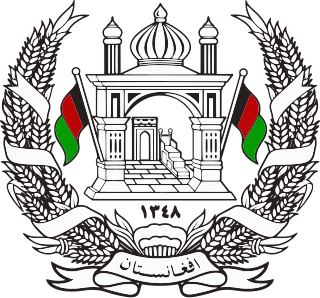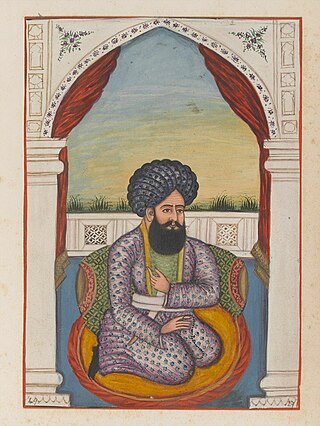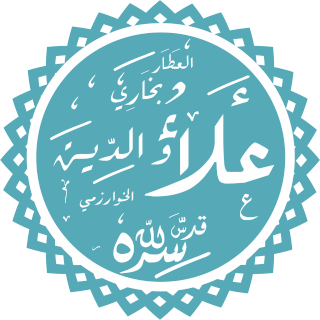Related Research Articles

Sayyid is an honorific title of Hasanids and Husaynids Muslims, recognized as descendants of the Islamic prophet Muhammad through his grandsons, Hasan ibn Ali and Husayn ibn Ali, sons of Muhammad's daughter Fatima and his cousin and son-in-law Ali.

The Naqshbandi order is a Sufi order of Sunni Islam named after Baha al-Din Naqshband. They trace their silsila (chain) to Prophet Muhammad through the first caliph Abu Bakr by the way of Ja'far al-Sadiq.

His/Her Serene Highness is a style used today by the reigning families of Liechtenstein, Monaco and Thailand. Over the past 400 years, it has also been used as a style for senior members of the family of Hazrat Ishaan, who are believed to succeed Prophet Muhammad based on the 1400 year old Sunni Sayyid ul Sadatiyya line of Imamate of Ahlul Bayt. Until 1918, it was also associated with the princely titles of members of some German ruling and mediatised dynasties and with a few princely but non-ruling families. It was also the form of address used for cadet members of the dynasties of France, Italy, Russia and Ernestine Saxony, under their monarchies. Additionally, the treatment was granted for some, but not all, princely yet non-reigning families of Bohemia, Hungary, Italy, Poland, Romania and Russia by emperors or popes. In a handful of rare cases, it was employed by non-royal rulers in viceregal or even republican contexts.

The Qadiriyya or the Qadiri order is a Sufi mystic order (tariqa) named after Abdul Qadir Gilani, who was a Hanbali scholar from Gilan, Iran. The order relies strongly upon adherence to the fundamentals of Sunni Islamic law.

Khwājagān is a Persian title for "the Masters". Khwajagan, as the plural for "Khwāja", is often used to refer to a network of Sufis in Central Asia from the 10th to the 16th century who are often incorporated into later Naqshbandi hierarchies, as well as other Sufi groups, such as the Yasaviyya. In Firdowsi's Shahnama the word is used many times for some rulers and heroes of ancient Iran as well. The special zikr of the Khwajagan is called 'Khatm Khajagan'.

The Barakzai dynasty also known as the Muhammadzai dynasty ruled modern day Afghanistan from 1823 to 1978 when the monarchy ended de jure under Musahiban Mohammad Zahir Shah and de facto under his cousin Sardar Mohammad Daoud Khan. The Barakzai dynasty was established by Dost Mohammad Khan after the Durrani dynasty of Ahmad Shah Durrani was removed from power. The Muhammadzai era was known for its progressivist modernity in which Afghanistan was referred to as the "Switzerland of Asia".

The Imamiyya-Ridhawiyya-Mahdawiyya-Qadiriyya-Naqshbandiyya-Ishaniyya Line of Succession also known as the Sayyid ul Sadatiyya, is a cognatic Sunni line of hereditary succession to Muhammad and vice-gerency of the 12th Imam Muhammad ibn Hasan al Mahdi in occultation. It is an Orthodox-Sunni school with a central emphasis on the teachings of the Muslim Saint Sayyid Mir Jan. It is the hereditary line of supreme leadership (Ishaniyat) over the Naqshbandi Sufi Order. The line is also called the Qadiriyya wa Naqshbandiyya hereditary line of succession to Muhammad and representation of the 12th Imam, differing from the Twelver-Shia tradition in honor of their namesake ancestors the Hanbali Imam Sayyid Abdul Qadir Gilani and his cognatic descendant the Hanafi Scholar Sayyid Bahauddin Naqshband.

Ziyarat Naqshband Sahab is a Sunni Muslim shrine, or ziyarat, in Srinagar in Jammu and Kashmir, India. It is one of the traditional Mausoleums of the Hazrat Ishaans, who are descendants of Bahauddin Naqshband and Mughal royals. Besides the Ziyarat Naqshband Sahab in Srinagar, Kashmir, the Hazrat Ishaans have a Ziyarat in Lahore in Begampura.

Sayyid Mir Jan Shah Saheb ibn Hasan Naqshbandi was a Sunni saint from Kabul.
Naqib al-ashraf was a governmental post in various Muslim empires denoting the head or supervisor of the descendants of the Islamic prophet Muhammad. The descendants of Muhammad were known as ashraf and throughout Islamic history, the ashraf organized themselves into large groups, akin to corporations, throughout the various Muslim territories. This was done to ensure their special place in Muslim society and thus maintain their socio-political privileges.

ʿAbd al-Razzāq b. ʿAbd al-Qādir al-Jīlānī, also known as Abū Bakr al-Jīlī or ʿAbd al-Razzāq al-Jīlānī for short, or reverentially as Shaykh ʿAbd al-Razzāq al-Jīlānī by Sunni Muslims, was a Persian Sunni Muslim Hanbali theologian, jurist, traditionalist and Sufi mystic based in Baghdad. He received his initial training in the traditional Islamic sciences from his father, Abdul-Qadir Gilani, the founder of the Qadiriyya order of Sunni mysticism, prior to setting out "on his own to attend the lectures of other prominent Hanbali scholars" in his region. He is sometimes given the Arabic honorary epithet Tāj al-Dīn in Sunni tradition, due to his reputation as a mystic of the Hanbali school.

Hazrat Ishaan was an influential Sunni saint from Bukhara, Uzbekistan.

Sultan Mohammad Khan, also known as Ghazi Sardar Sultan Mohammad Talaei, and known by his epithet, Sultan Mohammad Khan the Golden was an Afghan chief minister and regent. He was a powerful brother of Emir Dost Mohammad Khan, the eventual ruler of Afghanistan who seized control of Kabul from him. Prior to and during the reign of Dost Mohammad Khan, Sultan Muhammad Khan Telai was chief minister and governor of various regions of Afghanistan, including Kabul, Peshawar and Kohat. He was the first of the Musahiban, a Mohammadzai dynasty that began with him and ruled Afghanistan for more than 150 years, in various forms such as emir, king or president from 1823 to 1978.

Mir Sayyid Mahmud Agha, officially known as Sayyid ul Sadaat Mir Sayyid Mahmud Saheb Agha ibn Mir Hasan Gilani-Naqshbandi al-Hasani wal-Husseini was a Sufi saint of South Asia. He was the brother of Sayyid Mir Jan and acted under him as Grand Master of the Naqshbandi Sufi order. Together with his brother, he preached the legacy of their ancestor Hazrat Ishaan.
Sayyid Ali al-Akbar ibn al-Hasan was a Sunni Muslim saint, and according to some historians of genealogy the second son of Imam Hasan al-Askari, the eleventh Imam in Shia Islam. He was also the brother of the twelfth Imam Muhammad al-Mahdi. His existence was hidden because of contemporary political conflicts with the political leadership of the Abbasids, reaching its peak at that time.

Sayyid ul-Sadaat Sayyid Moinuddin Hadi Gilani-Naqshband al-Hasani wal-Husseini, known as "Hazrat Naqshband Saheb", was a Sunni Muslim wali (saint) from Bukhara and direct descendant of Muhammad, through his father Hazrat Ishaan who was a seventh generation descendant of Bahauddin Naqshband. Moinuddin Naqshband succeeded his father in leading the Silsile Aliyya Naqshbandiyya.
Mir Sayyid Hasan ibn Azimullah was an Emir of a group of Sunni Sayyids of Khorasan, following the Sayyid ul Sadatiyya heritage. His descendants were confirmed as Emirs of the Afghan Sayyids and custodians of the Hazrat Ali Shrine by the Muhammadzai Royal Dynasty.

Khwaja Sayyid Mir Alauddin ibn Muhammad Attar, was a Sufi Saint from Bukhara and Qutb of the Naqshbandi Sufi order. He was a descendant of Muhammad and son in law of his master and predecessor Khwaja Bahauddin Naqshband.

Sayyid Kastir Gul (1573–1653) was an Islamic jurist and Sufi saint who is revered among Afghans and Pakistanis. He is the patriarch of the Kakakhel tribe.

Abu al Barakat Sayyid Imam Ali Shah (1798-1865) was a senior Indian Sufi Saint. He was of the Qadiri Naqshbandi Sufi Order. He is from Rattar Chhattar a village in Punjab that is called "the noble sanctuary" in his honor. In the Qadiri Naqshbandi Sufi Order he is venerated as the "sustainer of the order in the world".
References
- ↑ Sadat in Khwajagan Naqshband, Chapter 7
- ↑ Qasoori in Tazkar-e-Khanwade Hazrat Ishaan, p. 281
- ↑ Imam Ali ibn al-Hussein (2001). The Complite Edition of the Treatise on Rights. Qum: Ansariyan Publications.
- ↑ Sharif al-Qarashi2, Baqir (2000). The Life Of Imam Musa Bin Ja'far aL-Kazim (PDF). Translated by Jasim al-Rasheed. Iraq: Ansarian
- ↑ Tazkare Khwanadane Hazrat Eshan(genealogy of the family of Hazrat Eshan)(by author and investigator:Muhammad Yasin Qasvari Naqshbandi company:Edara Talimat Naqshbandiyya Lahore), p. 65
- ↑ Khtame Ziarate Sharife hazrat eshan Bukhari(written and investigated by Mian Ahmad Bader Akhlaq(BSC)) printed the second time in 1988 Writer and inspector Mian Muhammad Hasan Akhlaq (M.Km) 1988 company: Koperatis Lahorin
- ↑ "Shajara-e-nasab lineages of descendants of Imam Hasan al-Askari r.a.-Shajara.org" . Retrieved 2020-06-29.
- ↑ al-Kafi, by Muhammad Ya'qub Kulayni. Translated by Muhammad Sarwar. Chap. 124, Birth of Abi Muhammad al-Hasan ibn 'Ali, p. 705
- ↑ Dr.Annemarie Schimmels book "Pain and Grace: A Study of Two Mystical Writers of Eighteenth-Century Muslim India" BRILL, 1976, p. 32
- ↑ Khtame Ziarate Sharife hazrat eshan Bukhari(written and investigated by Mian Ahmad Bader Akhlaq (BSC)) printed the second time in 1988 Writer and inspector Mian Muhammad Hasan Akhlaq(M.Km) 1988 company: Koperatis Lahorin
- ↑ Sultanova, Razia (2011). "Naqshbandiyya". From Shamanism to Sufism. I.B.Tauris. p. 32-37. ISBN 978-1-84885-309-6.
- ↑ "Nazaria-i-Pakistan Trust".
- ↑ Expanding Frontiers in South Asian and World History: Essays in Honor of John F.Richards p. 159
- ↑ Khtame Ziarate Sharife hazrat eshan Bukhari(written and investigated by Mian Ahmad Bader Akhlaq(BSC)) printed the second time in 1988 Writer and inspector Mian Muhammad Hasan Akhlaq(M.Km) 1988 company: Koperatis Lahorin
- ↑ "Nazaria-i-Pakistan Trust".
- ↑ Expanding Frontiers in South Asian and World History: Essays in Honor of John F.Richards p. 159
- ↑ the Naqshbandiyya: Orthodoxy and activism in a worldwide Sufi tradition" written and investigated by: Itzchak Weismann; company: Routledge Taylor & Francis Group (p. 52)
- ↑ Tazkare Khwanadane Hazrat Eshan(genealogy of the family of Hazrat Eshan)(by author and investigator:Muhammad Yasin Qasvari Naqshbandi company:Edara Talimat Naqshbandiyya Lahore)p.335, Khawajagan Naqshband, by Mir Assadullah Sadat, Chapter 8
- ↑ Tazkare Khwanadane Hazrat Eshan(genealogy of the family of Hazrat Eshan)(by author and investigator:Muhammad Yasin Qasvari Naqshbandi company:Edara Talimat Naqshbandiyya Lahore)p.335, Khwajagan Naqshband, Mir Assadullah Sadat, Chapter 8
- ↑ Tazkare Khwanadane Hazrat Eshan(genealogy of the family of Hazrat Eshan)(by author and investigator:Muhammad Yasin Qasvari Naqshbandi company:Edara Talimat Naqshbandiyya Lahore)p.335 ff; Khwajagan Naqshband, by Mir Asadullah Sadat, chapter 8
- ↑ Khwajagan Naqshband, by Mir Asadullah Sadat, chapter 8
- ↑ Khtame Ziarate Sharife hazrat eshan Bukhari(written and investigated by Mian Ahmad Bader Akhlaq(BSC)) printed the second time in 1988 Writer and inspector Mian Muhammad Hasan Akhlaq(M.Km) 1988 company: Koperatis Lahorin
- ↑ Tazkare Khanwade Hazrat ishaan, Edarat Talimat naqshbandiyya, by Muhammad Yasin Qasvari, p. 312
- ↑ Khwajagan Naqshband, by Mir Asadullah Sadat, chapter 8
- ↑ Khtame Ziarate Sharife hazrat eshan Bukhari(written and investigated by Mian Ahmad Bader Akhlaq(BSC)) printed the second time in 1988 Writer and inspector Mian Muhammad Hasan Akhlaq(M.Km) 1988 company: Koperatis Lahorin
- ↑ Tazkare Khanwade Hazrat ishaan, Edarat Talimat naqshbandiyya, by Muhammad Yasin Qasvari, p. 312
- ↑ Tazkare Khwanadane Hazrat Eshan(genealogy of the family of Hazrat Eshan)(by author and investigator:Muhammad Yasin Qasvari Naqshbandi company:Edara Talimat Naqshbandiyya Lahore), p. 65
- ↑ Christopher Buyers in the Royal Ark, Afghan Royal Family, Chapter: Telai III
- ↑ https://rp-online.de/nrw/staedte/wesel/hamminkeln-sultan-masood-dakik-aus-bruenen-will-afghanen-helfen_aid-98991273
- ↑ https://www.vaterland.li/liechtenstein/politik/nicht-anerkannter-sondergesandter-fuer-afghanischen-prinzen-art-550793
- ↑ Tazkare Khwanadane Hazrat Eshan(genealogy of the family of Hazrat Eshan)(by author and investigator:Muhammad Yasin Qasvari Naqshbandi company:Edara Talimat Naqshbandiyya Lahore)p.281
- ↑ Khtame Ziarate Sharife hazrat eshan Bukhari(written and investigated by Mian Ahmad Bader Akhlaq(BSC)) printed the second time in 1988 Writer and inspector Mian Muhammad Hasan Akhlaq(M.Km) 1988 company: Koperatis Lahorin